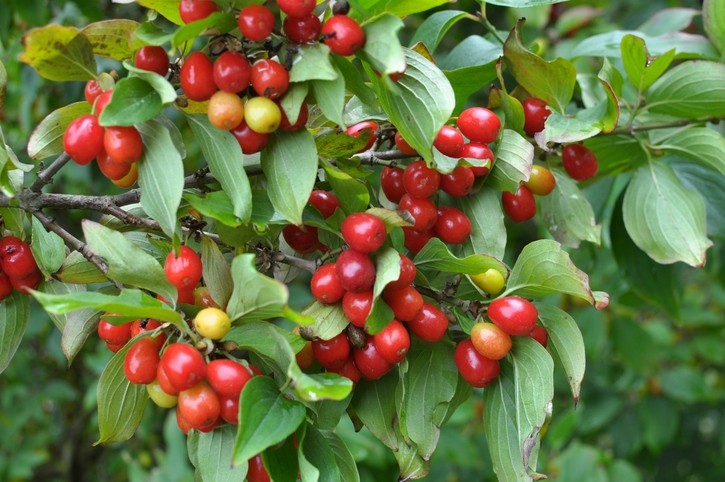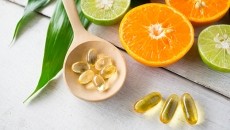Research reveals how ripening impacts active compounds in cornelian cherry

Published in the journal Antioxidants, the research illustrates in detail that quality attributes and the content of health-promoting phytocompounds in CC depend on the ripening stage and on the cultivar.
"Our findings can be helpful to select the optimal properties of CC for the development of diverse functional foods and phytopharmaceuticals," the team of Polish researchers wrote.
A total of 52 metabolites were identified by UPLC-ESI-qTOF-MS/MS and quantified by HPLC-PDA to define the physicochemical attributes, composition and antioxidant capacity of four Polish cultivars of CC at six stages of development and ripening.
In general, phenolic acids, hydrolyzable tannins, flavonols, iridoids, antioxidant activity, organic acids and vitamin C decreased, while anthocyanins, malic acid, sugars and titratable acidity increased over time.
The team concluded that while ripe CC is known for its rich composition of bioactive substances, particularly those with antioxidant, anti-inflammatory and antidiabetic properties, they argue that unripe fruits are particularly valuable as they contain the highest content of total bioactive phytocompounds and the highest antioxidant capacity.
Benefits of cornelian cherry
Ripe CC has been widely discussed in the scientific literature due to its wide range of health-promoting compounds, including natural antioxidants, polyphenols (phenolic acids, hydrolysable tannins, anthocyanins, flavonols), iridoids, vitamin C, fiber and unsaturated fatty acids.
Research has confirmed many benefits of both individual compounds present in CC or their synergistic action, including antioxidative (polyphenols), anti-inflammatory (loganic acid), antidiabetic (homogenized fruits, anthocyanins gallotannins and ellagitanins), anti-osteoporotic (loganic acid), antibacterial (tellimagrandin I), hepatoprotective (anthocyanins, iridoids, ellagitannins, CC extract), antiglaucomic (loganic acid), neuroprotective and more.
The ripening impact
For this study, 80 fruits were harvested at six ripening stages and immediately frozen at –20 °C until the analysis. The flesh and skin were manually separated from pits, homogenized using a blender and analyzed immediately.
Resulting data indicated that unripe fruits contained the highest content of total bioactive phytocompounds (5589.1–6779.6 mg/100 g dw)—primarily phenolic acids, iridoids and tannins, and the highest antioxidant capacity.
The intermediate stages or ripening were the most abundant in vitamin C (341.1–495.6 mg/100 g dw), ellagic acid (5.9–31.6 mg/100 g dw), gallotannins (47.8–331.1 mg/100 g dw) and loganic acid (1393.0–2839.4 mg/100 g dw).
The ripe fruits contained less bioactive phytocompounds (1403.7–1974.6 mg/100 g dw)—primarily iridoids, phenolic acids, tannins and anthocyanins—and the lowest antioxidant capacity.
On the other hand, ripe fruits showed the highest content of anthocyanins (30.8–143.2 mg/100 g dw), sugars (36.4–78.9 g/100 g dw), malic acid (5.5–12.2 g/100 g dw) and, favorably for nutritional applications, the highest sugar-to-acids ratio (3.0–6.4).
"The metabolic behavior of the individual compounds and the groups of compounds was revealed for the first time, providing a new approach for the utilization of cornelian cherry fruits," the researchers concluded. "Understanding those changes at different degrees of ripening enables the choice of the most accurate composition and properties of CC.
"Unripe fruits are an excellent source of bioactive molecules, richer than ripe fruits, which makes them a highly valuable resource for the design of dietary supplements for prophylaxis or natural-origin pharmaceuticals. Therefore, the application of green cornelian cherry should be investigated in the future[...]"
"Nonetheless, ripe CC still provides bioactive compounds in different concentrations or with slightly different profiles, but at the same time, it provides dietary antioxidants and is a good raw material for new functional foods," they added.
Source: Antioxidants
doi: 10.3390/antiox13020229
"The Health-Promoting Quality Attributes, Polyphenols, Iridoids and Antioxidant Activity during the Development and Ripening of Cornelian Cherry (Cornus mas L.)"
Authors: Dominica Przybylska et a.












